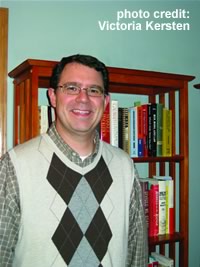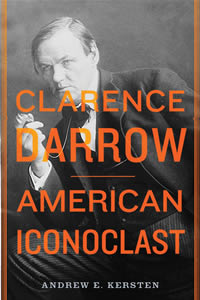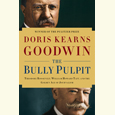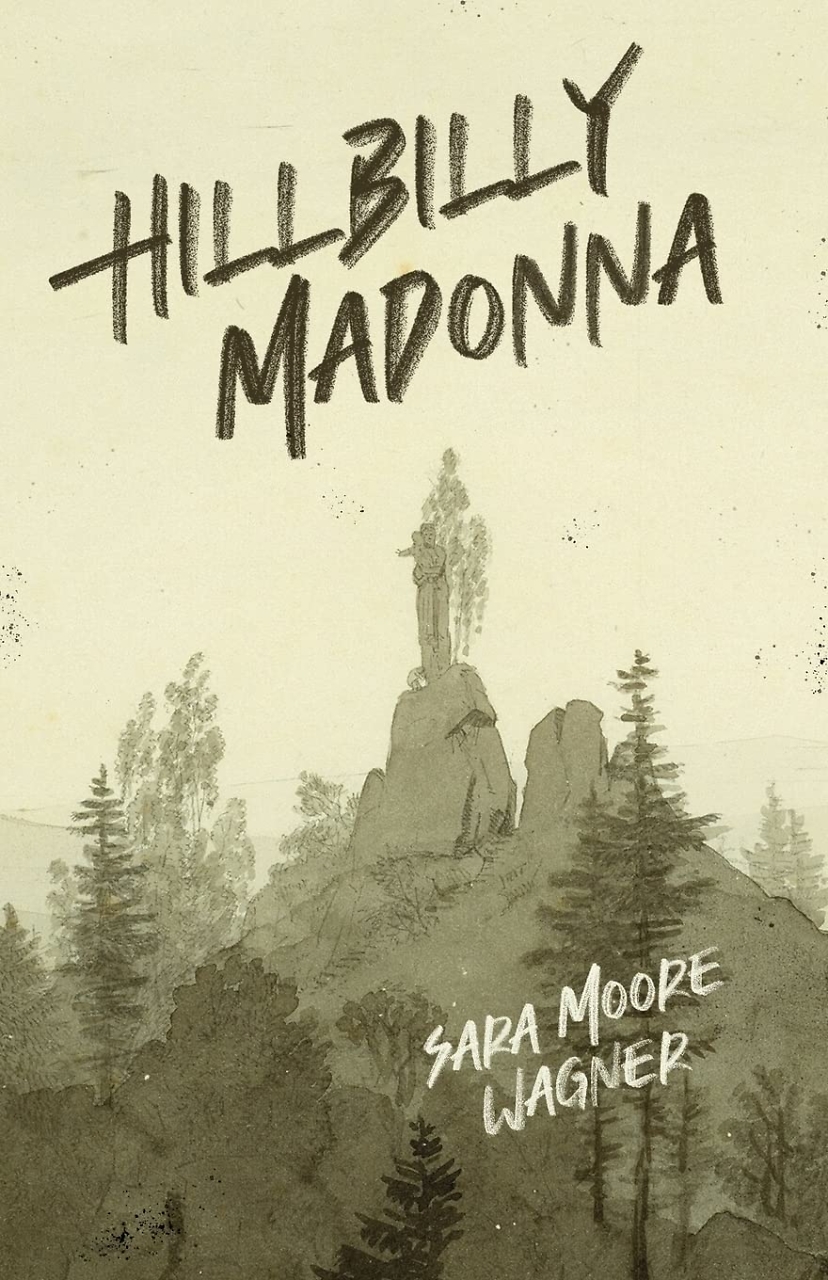The Hopeful Pessimist
A biography of famed attorney Clarence Darrow describes a man of conflicting alliances and steadfast principles
Legendary American attorney Clarence Darrow is best known for two cases: his defense of Nathan Leopold and Richard Loeb in the 1924 thrill killing of fourteen-year-old Bobby Franks, and his 1925 defense of John T. Scopes’s right to teach evolution in his Dayton, Tennessee, classroom. Though his import extends far beyond these trials, it’s significant that they remain at the forefront of Darrow lore. Whether in the defense of the lowly (Scopes) or the infamous (Loeb and Leopold), Darrow was a brilliant rhetorician who wasn’t afraid to get his hands muddy in the service of his clients.
This is the theme of Clarence Darrow: American Iconoclast, Andrew E. Kersten’s biography of the “the attorney for the damned,” as Darrow was known. Though Darrow has been portrayed before—most famously in the highly fictionalized play Inherit the Wind and in Irving Stone’s biography Clarence Darrow for the Defense—Kersten focuses on his inconsistencies and his uncanny ability to balance such seemingly contradictory impulses as social justice and legal justice. Though Darrow would champion many unpopular causes, dumbfounding his progressive friends and empowering his conservative enemies, he remained at heart an attorney of the people, concerned more with preserving individual liberties and tilting at institutional windmills than with maintaining a consistent philosophy.
 Unlike biographers such as Stone, Kersten doesn’t dwell on Darrow’s childhood. Darrow was born of freethinking parents and spent his youth in the small Ohio farm town of Kinsman. He attended Allegheny College and the University of Michigan Law School, but failed to graduate from either institution. In 1878 he was admitted to the Ohio Bar (in those days, a university degree wasn’t required) and began to practice law in Ashtabula, with limited success. For Kersten, however, Darrow didn’t become Darrow until he moved his young family to Chicago ten years later. “No Chicago; no attorney for the damned,” he writes.
Unlike biographers such as Stone, Kersten doesn’t dwell on Darrow’s childhood. Darrow was born of freethinking parents and spent his youth in the small Ohio farm town of Kinsman. He attended Allegheny College and the University of Michigan Law School, but failed to graduate from either institution. In 1878 he was admitted to the Ohio Bar (in those days, a university degree wasn’t required) and began to practice law in Ashtabula, with limited success. For Kersten, however, Darrow didn’t become Darrow until he moved his young family to Chicago ten years later. “No Chicago; no attorney for the damned,” he writes.
Post-Civil War Chicago was both a hotbed and a hellhole. Capitalism, opulence, and corruption maintained an uneasy hand over free thought, activism, and unimaginable poverty. “While Darrow figured that there would be plenty of room for a smart, enterprising, politically savvy lawyer, he had other reasons to believe that he would find like-minded friends and mentors. Much more than Ashtabula, Chicago was awash in political and social movements.”
In Chicago, Darrow rubbed shoulders with reformers like Henry George, Henry D. Lloyd and John Peter Altgeld, the latter of whom would become the young attorney’s mentor. He quickly affiliated with the progressive cause, adopting reformist views on everything from labor relations to free love. Through Altgeld, he secured a job as the city’s special assessment attorney, becoming then-mayor De Witt C. Cregier’s labor troubleshooter. As such, Darrow was asked to assist in settling a long held dispute between Spring Valley, Illinois, coal miners and their employer, the Spring Valley Coal Company. The effort failed, but Darrow was on the path of becoming, as Kersten calls him, “labor’s greatest champion and a strident defender of American liberty and freedom.”
Darrow would experience more defeats as he transitioned between corporate jobs, speaking engagements, political posts, and various law partners. His fortunes changed somewhat, however, when he was called to defend Eugene V. Debs, an American Railway Union official who had been arrested for his role in the 1894 Pullman railroad strike. According to Kersten, Darrow’s decision to take the case to the United States Supreme Court would change not only his life but American history itself. Though he would eventually lose the case—Darrow often seemed to gain more in defeat than in victory—he was able to get Debs, a labor hero, released on bail. Darrow was now officially labor’s man. His impassioned defense of Debs galvanized populist revolt and hardened his own resolve. “The entire case had put a nearly unquenchable fire in his stomach,” writes Kersten.
 Darrow’s distrust of institutions eventually extended to mass movements themselves. Labor organizations were unwieldy and uncooperative, and feminists, bohemians, and workers tended to vote against their own interests, thus thwarting reform at ground level. Increasingly, Darrow would be more pragmatic in his operations. In 1903, for example, he supported the re-election of Chicago mayor Harrison Carter II in spite of the incumbent’s anti-labor reputation. His progressive friends were livid, but Darrow knew that Harrison’s challenger, labor candidate Daniel L. Cruice, didn’t stand a chance—better to back Harrison than to go down with labor’s ship, according to Kersten: “This was the first but certainly not the last time that Darrow made this kind of political calculus and showed a willingness to abandon people and ideas for the sake of some larger goal in the name of freedom and liberty.”
Darrow’s distrust of institutions eventually extended to mass movements themselves. Labor organizations were unwieldy and uncooperative, and feminists, bohemians, and workers tended to vote against their own interests, thus thwarting reform at ground level. Increasingly, Darrow would be more pragmatic in his operations. In 1903, for example, he supported the re-election of Chicago mayor Harrison Carter II in spite of the incumbent’s anti-labor reputation. His progressive friends were livid, but Darrow knew that Harrison’s challenger, labor candidate Daniel L. Cruice, didn’t stand a chance—better to back Harrison than to go down with labor’s ship, according to Kersten: “This was the first but certainly not the last time that Darrow made this kind of political calculus and showed a willingness to abandon people and ideas for the sake of some larger goal in the name of freedom and liberty.”
At times Darrow’s pragmatism got him into legal trouble. There’s evidence to suggest that his behavior wasn’t entirely beyond reproach, as accusations of bribery and jury tampering swirled around him. He was tried for bribery in Los Angeles in 1912 but found not guilty. Regarding such accusations, Darrow was nonplussed. “Darrow’s legal career was not an end unto itself,” says Kersten. “He did not seek the approbation of his peers. He was a lawyer so that he could fight for the poor, the weak, and the oppressed.”
Of course there was nothing poor, weak, or oppressed about Richard Leopold and Nathan Loeb, two children of Chicago aristocracy who ruthlessly murdered a young neighborhood boy in 1924. In this case “the larger goal” at stake was Darrow himself, who was constantly strapped for cash and needed the high-profile case to stay afloat. Darrow successfully saved the boys lives—they received life in prison—but his remuneration, $30,000, was only a fraction of what was expected. Still, Darrow made a show for civil liberties: “Darrow urged the judge to join him in rejecting capital punishment and rendering a decision that demonstrated that all life is worth saving.”
In both practice and temperament Kersten’s Darrow is an artful crank; a “hopeful pessimist,” as the author says, unafraid to cast aside concepts and people in service of an overarching progressivism. Like an artist, Darrow the public speaker created compelling images that shook the taken-for-granted world of his audience—in this case, a jury’s notion of guilt or innocence. Kersten reports of these events in a gripping, edge-of-the-seat narrative, which—like Darrow’s life—is action-packed to the end. In an afterword, Kersten refuses to conjecture about where Darrow might stand on civil rights in the post-September 11 era. “Darrow and his commitments were malleable,” he says. “Yet there is something irreducible about him too. For five decades, an amazingly long time in American politics, he fought to expand liberties, rights and freedoms so that average people could have a fair chance of living the American dream.”


